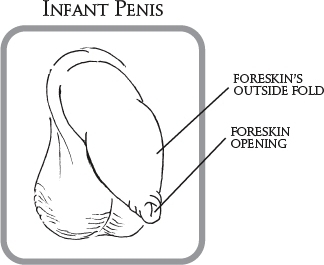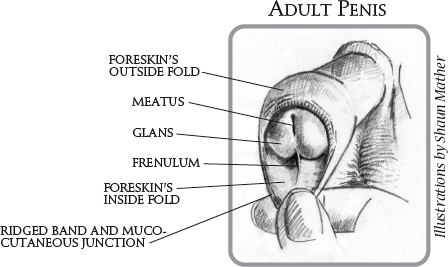
|

|
|
3 |
NOCIRC Information Series: Infant Circumcision |
Circumcision is the cutting off of the fold of skin that normally covers and protects the glans (head) of the penis. This double layer of skin, the prepuce, is commonly known as the foreskin.

|

|
The foreskin comprises as much as half, or more, of the penile skin system and has three known functions: protective, sensory, and sexual.
During infancy, the foreskin is attached to the glans and protects it from urine, feces, and abrasions from diapers. Throughout life, the foreskin keeps the glans soft and moist and protects it from trauma and injury. Without this protection, the glans becomes dry, calloused, and desensitized from exposure and chafing.
Specialized nerve endings in the foreskin enhance sexual pleasure.
The foreskin may have functions not yet recognized or understood.
"The foreskin protects the glans throughout life."- American Academy of Pediatrics |
Doctors in the English-speaking countries started circumcising babies in the mid-1800s "to prevent masturbation," which was blamed for causing many diseases, including epilepsy, tuberculosis, and insanity. Other reasons have been given since then, but all of them, including the claim that circumcision prevents cancer of the penis, cancer of the cervix, and venereal diseases, have been disproven. We now know that the foreskin is a normal, sensitive, functional part of the body.
Raising an intact boy should include empowering him to compassionately respond to anyone who might ever tease him about being normal and whole.
"Nature is a possessive mistress, and whatever mistakes she makes about the structure of the less essential organs such as the brain and stomach, in which she is not much interested, you can be sure that she knows best of the genital organs."- Sir James Spence |
Yes. Circumcision is extremely painful - and traumatic - for a baby. Just being strapped down is frightening for a baby. The often repeated statement that babies can't feel pain is not true. Babies are as sensitive to pain as anyone else. Most babies scream frantically when their foreskin is cut off. Some defecate. Some lapse into a coma. The reason some babies don't cry when they are circumcised, is that they can't cry because they are in a state of shock. Most babies are circumcised without anesthesia. Anesthetics injected into the penis don't always work. Being stuck with a needle in the penis is itself painful for a baby, just as if would be for anyone else. Babies are rarely given pain medicatiion right after they are circumcised or during the week to ten days it takes for the wound to heal. Pain medication is not always effective and is never 100% effective.
Yes. Like any other surgery, circumcision has risks. They include:
|
Many circumcised males suffer from:
|
All circumcised males lose some or most of the sensitivity in their glans and all of the sensitivity in their foreskin.
Circumcision may have risks and complications not yet recognized or understood.
"Routine circumcision is not a medical issue or a social issue. It is a sexual issue and a human rights issue."- Frederick Hodges |
Most parents don't know what is actually done to a baby when he is circumcised. The baby is placed spread-eagle on his back on a board and his arms and legs are strapped down so that he can't move. His genitals are scrubbed and covered with antiseptic. His foreskin is torn from the glans and slit lengthwise so that the circumcision instrument can be inserted. Then his foreskin is cut off.
Most parents who see what is done to a baby when he is circumcised and how he reacts decide against circumcision and let their baby keep his foreskin intact.
More and more parents - including Jewish & Muslim parents - are questioning the wisdom of subjecting their baby to the pain and risks of circumcision and its life-long consequences. More and more parents are wondering if they have the right to consent to the irreversible amputation of a healthy, normal, sensitive, functional part of their baby's penis - an amputation that experts regard not just as unnecessary, but as contrainidicated. More and more parents are becoming truly informed and, as a result, more and more parents are deciding against circumcision and are keeping their baby boys intact.
"The best reason to let a baby keep his foreskin intact is that it's almost a certainty that he will be glad you did."- John A. Erickson~ ~ ~"Many parents today realize that if they had been given accurate information about circumcision, they would never have let anyone circumcise their baby. I am one of those parents, and that is why I do the work I do and why I have written this pamphlet."- Marilyn Fayre Milos, R.N. |
No national or international medical association recommends circumcision.
More information can be found at: www.nocirc.org and www.cirp.org
NOCIRC pamphlets: Ten different pamphlets: 50¢ each or $25/100 (same or mixed) plus $5 S/H.
The NOCIRC Resource Guide lists the
pamphlets, books, articles, newsletters, and videos available from
NOCIRC, and other resources as well. Free for SASE.
National Organization of Circumcision
Information Resource Centers
Post Office Box 2512
San Anselmo, CA 94979-2512 USA
Telephone: 415-488-9883
Fax: 415-488-9660
www.nocirc.org
The information in this pamphlet is not meant to replace the care and advice of your pediatrician.
11/04
Back To: NOCIRC Publications Main Page.